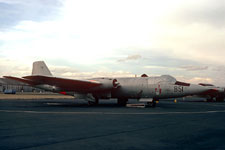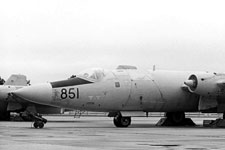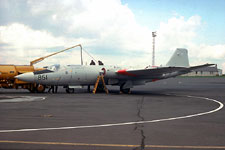| WH797's service history
WH797 was ordered by the Royal Air Force as a PR.3 Canberra, but was brought to PR.7 configuration on the production line by English Electric.
It was declared ready for collection on 13th May 1954, and received its first military posting shortly after when it issued to RAF 542 Squadron (Sqn) at Wyton, a Unit that had began replacing its Canberra PR.3 airframes. Unfortunately the time it served with the Unit is unknown at the time of writing, but it is confirmed that the aeroplane was later transferred to RAF 58 Sqn, also based at RAF Wyton.
In early 1958, RAF 81 Sqn based in Tengah began receiving Canberra PR.7s, establishing itself as the only Far East Air Force (FEAF) photo reconnaissance unit. WH797 was one of its airframes, and it remained in service until the Squadron disbanded in January 1971, when it was flown back to the UK and placed in store at RAF Athan.
On 15th February 1971, WH797 was one of seven Canberra PR.7s transferred to the Royal Navy at St Athan, for conversion to T.22 specification.
The airframe was moved to the British Aircraft Corporation (BAC) factory at Salmesbury, where work was begun to transform it into a radar trainer for the Fleet Air Arm. On 20th December 1973, WH797 was ferried to RNAS Yeovilton where it joined the Fleet Requirements and Air Direction Training Unit (FRADTU) as aeroplane '851'. It remained in use for the rest of the decade, aside from spells at RAF Aldergrove for a major inspection (March-June 1975), RNAS Lee-on-Solent (June 1975-September 1975) and finally RAF Kemble for a refinish (May-July 1978). On 18th July 1980, WH797 was moved to RAF St Athan for a second major inspection and was out of action for the next fifteen months.
The aeroplane was returned to Fleet Air Arm service in October 1981, when it was moved to RNAS Lee-on-Solent to begin a stint with the Navy Aircraft Trials Installation Unit (NATIU). Returning to FRADU un-coded on 20th May 1982, it was placed on loan to the Ministry of Defence less than a month later for trial purposes. It did not actually return to Yeovilton until August 1983, and aside from another short spell with the NATIU at Lee-on-Solent in February 1984, WH797's service with FRADU was steady until its withdrawal a year later on 27th February 1985, after its role was taken over by converted civilian-owned Falcon 20 business jets. Redundant, WH797 was moved to RAF St Athan for storage, and remained there for the next seven years until being offered for disposal. |

[© Dave Jones]

[© Robin A. Walker]

[© Dave Jones]
|
WH797's civilian life
During April 1992, WH797 was offered for disposal via tender, and was subsequently acquired by Hanningfield Metals, based at Stock in Essex.
The airframe was scrapped, with the cockpit section moving to the company's home, leaving the rear fuselage at St Athan where it would eventually pass to the Station fire dump, expiring in May 1994. The cockpit section remained intact at Stock until May 1995, when it was scrapped following a clean-up of Hanningfield Metal's busy yard.
- December 2020 |